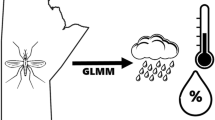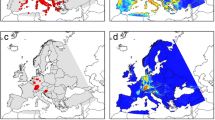Abstract
It has been suggested that climate change may have facilitated the global expansion of invasive disease vectors, since several species have expanded their range as temperatures have warmed. Here, we present results from observations on two major global invasive mosquito vectors (Diptera: Culicidae), Aedes albopictus (Skuse) and Aedes japonicus (Theobald), across the altitudinal range of Mt. Konpira, Nagasaki, Japan, a location within their native range, where Aedes flavopictus Yamada, formerly a rare species, has now become dominant. Spatial abundance patterns of the three species suggest that temperature is an important factor influencing their adult distribution across the altitudinal range of Mt. Konpira. Temporal abundance patterns, by contrast, were associated with rainfall and showed signals of density-dependent regulation in the three species. The spatial and temporal analysis of abundance patterns showed that Ae. flavopictus and Ae. albopictus were negatively associated, even when accounting for differential impacts of weather and other environmental factors in their co-occurrence patterns. Our results highlight a contingency in the expansion of invasive vectors, the potential emergence of changes in their interactions with species in their native communities, and raise the question of whether these changes might be useful to predict the emergence of future invasive vectors.



Similar content being viewed by others
References
Brunsdon C, Comber L (2015) An introduction to R for spatial analysis and mapping. Sage Publications LTD, London
Chaves LF (2016) Climate change and the biology of insect vectors of human pathogens. In: Johnson S, Jones H (eds) Invertebrates and global climate change. Wiley, Chichester, In Press
Chaves LF, Añez N (2016) Nestedness patterns of sand fly (Diptera: Psychodidae) species in a neotropical semi-arid environment. Acta Trop 153:7–13
Chaves LF, Koenraadt CJM (2010) Climate change and highland malaria: fresh air for a hot debate. Q Rev Biol 85:27–55
Chaves, L.F., Hamer, G.L., Walker, E.D., Brown, W.M., Ruiz, M.O. & Kitron, U.D. (2011). Climatic variability and landscape heterogeneity impact urban mosquito diversity and vector abundance and infection. Ecosphere, 2, art70.
Chaves LF, Morrison AC, Kitron UD, Scott TW (2012) Nonlinear impacts of climatic variability on the density-dependent regulation of an insect vector of disease. Glob Chang Biol 18:457–468
Chaves LF, Scott TW, Morrison AC, Takada T (2014) Hot temperatures can force delayed mosquito outbreaks via sequential changes in Aedes aegypti demographic parameters in autocorrelated environments. Acta Trop 129:15–24
Chaves LF, Imanishi N, Hoshi T (2015) Population dynamics of Armigeres subalbatus (Diptera: Culicidae) across a temperate altitudinal gradient. Bull Entomol Res 105:589–597
Egizi A, Fefferman NH, Fonseca DM (2015) Evidence that implicit assumptions of ‘no evolution’ of disease vectors in changing environments can be violated on a rapid timescale. Biological Sciences, Philosophical Transactions of the Royal Society of London B, p 370
Eisen L, Bolling BG, Blair CD, Beaty BJ, Moore CG (2008) Mosquito species richness, composition, and abundance along habitat-climate-elevation gradients in the Northern Colorado Front Range. J Med Entomol 45:800–811
Eshita Y, Kurihara T, Ogata T, Oya A (1982) Studies on the susceptibility of mosquitoes to dengue virus: I. Susceptibility of Japanese mosquitoes to the virus Japanese Journal of Sanitary Zoology 33:61–64
Faraway JJ (2006) Extending the linear model with R: generalized linear, mixed effects and nonparametric regression models. CRC Press, Boca Raton
Gaunt CMT, Mutebi J-P, Munstermann LE (2004) Biochemical taxonomy and enzyme electrophoretic profiles during development, for three morphologically similar Aedes species (Diptera: Culicidae) of the subgenus Stegomyia. J Med Entomol 41:23–32
Gotelli NJ, McCabe DJ (2002) Species co-occurrence: a meta-analysis of J. M Diamond’s assembly rules model Ecology 83:2091–2096
Hernandez MJ (2009) Disentangling nature, strength and stability issues in the characterization of population interactions. J Theor Biol 261:107–119
Hodkinson ID (2005) Terrestrial insects along elevation gradients: species and community responses to altitude. Biol Rev Camb Philos Soc 80:489–513
Hoshi T, Higa Y, Chaves LF (2014a) Uranotaenia novobscura ryukyuana (Diptera: Culicidae) population dynamics are denso-dependent and autonomous from weather fluctuations. Ann Entomol Soc Am 107:136–142
Hoshi T, Imanishi N, Higa Y, Chaves LF (2014b) Mosquito biodiversity patterns around urban environments in south-central Okinawa Island, Japan. J Am Mosq Control Assoc 30:260–267
Juliano SA (2009) Species interactions among larval mosquitoes: context dependence across habitat gradients. Annu Rev Entomol 54:37–56
Juliano SA, Lounibos LP (2005) Ecology of invasive mosquitoes: effects on resident species and on human health. Ecol Lett 8:558–574
Juliano S, Lounibos L, O’Meara G (2004) A field test for competitive effects of Aedes albopictus on A. aegypti in South Florida: differences between sites of coexistence and exclusion? Oecologia 139:583–593
Kamimura K (1968) The distribution and habit of medically important mosquitoes of Japan. Japanese J Sanit Zool 19:15–34
Kaufman MG, Fonseca DM (2014) Invasion biology of Aedes japonicus japonicus (Diptera: Culicidae). Annu Rev Entomol 59:31–49
Khibnik AI, Kondrashov AS (1997) Three mechanisms of Red Queen dynamics. Proc R Soc B Biol Sci 264:1049–1056
Kim HC, Klein TA, Lee WJ, Collier BW, Chong ST, Sames WJ et al (2007) Mosquito species distribution and larval breeding habitats with taxonomic identification of Anopheline mosquitoes in Korea. Entomol Res 37:29–35
Kobayashi M, Nihei N, Kurihara T (2002) Analysis of northern distribution of Aedes albopictus (Diptera:Culicidae) in Japan by geographical information system. J Med Entomol 39:4–11
Kuhn M, Johnson K (2013) Applied predictive modeling. Springer, New York
Kurashige Y (1961a) Ecological studies on mosquitoes in the bamboo groves of Tochigi Prefecture : III. Mosquito larvae in the stumps of bamboo (Madake) in Utsunomiya City. Japanese J Sanit Zool 12:30–35
Kurashige Y (1961b) Ecological studies on mosquitoes in the bamboo groves of Tochigi Prefecture: IV. Mosquito larvae in the bamboo groves in summer Japanese Journal of Sanitary Zoology 12:119–124
Larson R, Edwards BH (2013) Calculus., Brooks Cole Pacific Grove
Levins R (1968) Evolution in changing environments. Some theoretical explorations. Princeton University Press, Princeton
Lounibos LP (2002) Invasions by insect vectors of human disease. Annu Rev Entomol 47:233–266
Lounibos LP, O’Meara GF, Juliano SA, Nishimura N, Escher RL, Reiskind MH et al (2010) Differential survivorship of invasive mosquito species in South Florida Cemeteries: do site-specific microclimates explain patterns of coexistence and exclusion? Ann Entomol Soc Am 103:757–770
Makiya K (1974) Population dynamics of mosquitoes in Nagoya district B. Larval and imaginal populations of Aedes albopictus (Skuse) in a cemetery of Nagoya City. Japanese J Sanit Zool 25:41–49
Mangel M (2006) The theoretical biologist’s toolbox: quantitative methods for ecology and evolutionary biology. Cambridge University Press, Cambridge
Melbourne BA, Hastings A (2008) Extinction risk depends strongly on factors contributing to stochasticity. Nature 454:100–103
Miyagi I, Toma T (1989) Experimental crossing of Aedes albopictus, Aedes flavopictus downsi and Aedes riversi (Diptera : Culicidae) occurring in Okinawajima, Ryukyu Islands, Japan. Japanese J Sanit Zool 40:87–95
Mogi M (1996) Overwintering strategies of mosquitoes (Diptera: Culicidae) on warmer islands may predict impact of global warming on Kyushu, Japan. J Med Entomol 33:438–444
Mogi M, Tuno N (2014) Impact of climate change on the distribution of Aedes albopictus (Diptera: Culicidae) in northern Japan: retrospective analyses. J Med Entomol 51:572–579
Mori A, Wada Y (1978) The seasonal abundance of Aedes albopictus in Nagasaki. Tropical Medicine 20:29–37
Moriya K (1974) Seasonal trends of field population of mosquitoes with ovitrap in Kanagawa Prefecture : 1) Comparison of the populations of four residential areas in Kamakura City in 1971. Japanese J Sanit Zool 25:237–244
Omori N, Osima M, Bekku H, Fujisaki K (1952) On the mosquitoes found in Nagasaki prefecture. Contributions from the Research Institute of Endemics at Nagasaki University 27:281–284
Parmesan C (2006) Ecological and evolutionary responses to recent climate change. Annu Rev Ecol Evol Syst 37:637–669
Paupy C, Delatte H, Bagny L, Corbel V, Fontenille D (2009) Aedes albopictus, an arbovirus vector: from the darkness to the light. Microbes Infect 11:1177–1185
Post E (2013) Ecology of climate change: the importance of biotic interactions. Princeton University Press, Princeton
Proestos Y, Christophides GK, Ergüler K, Tanarhte M, Waldock J, Lelieveld J (2015) Present and future projections of habitat suitability of the Asian tiger mosquito, a vector of viral pathogens, from global climate simulation. Philos Trans R Soc Lond B Biol Sci 370:20130554
Shiraishi S (2011) Field collections of mosquito larvae in 2009 and 2010 in Ehime Prefecture, western Japan. Med Entomol Zool 62:109–116
Shumway RH, Stoffer DS (2011) Time series analysis and its applications, 3rd edn. Springer, New York
Sota T, Mogi M, Hayamizu E (1992) Seasonal distribution and habitat selection by Aedes albopictus and Ae riversi (Diptera, Culicidae) in Northern Kyushu, Japan. J Med Entomol 29:296–304
Stevens GC (1992) The elevational gradient in altitudinal range: an extension of Rapoport’s latitudinal rule to altitude. Am Nat 140:893–911
Sunahara T, Mogi M (2002) Variability of intra‐and interspecific competitions of bamboo stump mosquito larvae over small and large spatial scales. Oikos 97:87–96
Taira K, Toma T, Tamashiro M, Miyagi I (2012) DNA barcoding for identification of mosquitoes (Diptera: Culicidae) from the Ryukyu Archipelago, Japan. Med Entomol Zool 63:289–306
Tanaka K, Mizusawa K, Saugstad ES (1979) A revision of the adult and larval mosquitoes of Japan (including the Ryukyu Archipelago and the Ogasawara Islands) and Korea (Diptera: Culicidae). Contributions of the American Entomological Institute 16:1–987
Toma T, Miyagi I, Crabtree MB, Miller BR (2002) Investigation of the Aedes (Stegomyia) flavopictus Complex (Diptera: Culicidae) in Japan by Sequence Analysis of the Internal Transcribed Spacers of Ribosomal DNA. J Med Entomol 39:461–468
Tsuda Y, Takagi M, Wada Y (1994) Ecological study on mosquito communities in tree holes in Nagasaki, Japan, with special reference to Aedes albopictus (Diptera: Culicidae). Japanese J Sanit Zool 45:103–111
Tsuda Y, Maekawa Y, Saita S, Hasegawa M, Takagi M (2003) Dry ice-trap collection of mosquitoes flying near a tree canopy in Nagasaki, Japan, with special reference to Aedes albopictus (Skuse) and Culex pipiens pallens Coquillett (Diptera : Culicidae). Med Entomol Zool 54:325–330
Turchin P (2003) Complex population dynamics. Princeton University Press, Princeton
Vamosi SM, Heard SB, Vamosi JC, Webb CO (2009) Emerging patterns in the comparative analysis of phylogenetic community structure. Mol Ecol 18:572–592
Venables WN, Ripley BD (2002) Modern applied statistics with S. Springer, New York
Yamada S (1921) Descriptions of ten new species of Aedes found in Japan, with notes on the relation between some of these mosquitoes and the larva of Filaria bancrofti Cobbold. Annotationes Zoologicae Japonenses 10:45–81
Yamauchi T (2010) Mosquito species (Diptera: Culicidae) collected from the inhabited islands and trunk of Uwajima City, Shikoku, Japan. Med Entomol Zool 61:121–124
Yamauchi T (2013) Mosquitoes found along the coast of Toyama Prefecture, Japan. Pestology 28:17–20
Yang G-J, Bradshaw C, Whelan P, Brook B (2008) Importance of endogenous feedback controlling the long-term abundance of tropical mosquito species. Popul Ecol 50:293–305
Zea Iriarte WL, Tsuda Y, Wada Y, Takagi M (1991) Distribution of mosquitoes on a hill of Nagasaki city, with emphasis to the distance from human dwellings. Tropical Medicine 33:55–60
Acknowledgments
This study was funded by Sumitomo Foundation grant No. 153107 to LFC. Nagasaki City direction of green areas kindly provided all relevant permits to perform the study. Tomonori Hoshi and Nozomi Imanishi performed the net sweeping sampling and helped with mosquito identification. Finally, Ms. Junko Sakemoto provided valuable administrative support.
Author information
Authors and Affiliations
Corresponding author
Electronic supplementary material
Below is the link to the electronic supplementary material.
Supplement S1
(DOCX 29 kb)
Rights and permissions
About this article
Cite this article
Chaves, L.F. Globally invasive, withdrawing at home: Aedes albopictus and Aedes japonicus facing the rise of Aedes flavopictus . Int J Biometeorol 60, 1727–1738 (2016). https://doi.org/10.1007/s00484-016-1162-7
Received:
Revised:
Accepted:
Published:
Issue Date:
DOI: https://doi.org/10.1007/s00484-016-1162-7




